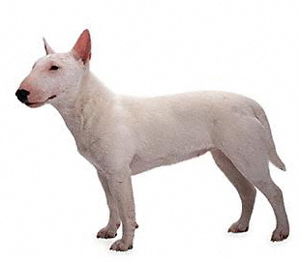Miniature Bull Terrier Breed Standard
General Appearance
The Miniature Bull Terrier must be strongly built, symmetrical and active, with a keen, determined and intelligent expression. He should be full of fire, having a courageous, even temperament and be amenable to discipline.
Size, Proportion, Substance
Height 10 inches to 14 inches. Dogs outside these limits should be faulted. Weight in proportion to height. In proportion, the Miniature Bull Terrier should give the appearance of being square.
Head
The head should be long, strong and deep, right to the end of the muzzle, but not coarse. The full face should be oval in outline and be filled completely up, giving the impression of fullness with a surface devoid of hollows or indentations, i.e., egg shaped. The profile should curve gently downwards from the top of the skull to the tip of the nose. The forehead should be flat across from ear to ear. The distance from the tip of the nose to the eyes should be perceptibly greater than that from the eyes to the top of the skull. The underjaw should be deep and well defined. hollows or indentations, i.e., egg shaped. The profile should curve gently downwards from the top of the skull to the tip of the nose. The forehead should be flat across from ear to ear. The distance from the tip of the nose to the eyes should be perceptibly greater than that from the eyes to the top of the skull. The underjaw should be deep and well defined.
To achieve a keen, determined and intelligent expression, the eyes should be well sunken and as dark as possible with a piercing glint. They should be small, triangular and obliquely placed, set near together and high up on the dog's head. The ears should be small, thin and placed close together, capable of being held stiffly erect when they point upwards. The nose should be black, with well developed nostrils bent downwards at the tip. The lips should be clean and tight. The teeth should meet in either a level or scissor bite. In the scissor bite, the top teeth should fit in front of and closely against the lower teeth. The teeth should be sound, strong and perfectly regular.
Neck, Topline, Body
The neck should be very muscular, long, and arched; tapering from the shoulders to the head, it should be free from loose skin. The back should be short and strong with a slight arch over the loin. Behind the shoulders there should be no slackness or dip at the withers. The body should be well rounded with marked spring of rib. The back ribs deep. The chest should be broad when viewed from in front. There should be great depth from withers to brisket, so that the latter is nearer to the ground than the belly. The underline, from the brisket to the belly, should form a graceful upward curve. The tail should be short, set on low, fine, and should be carried horizontally. It should be thick where it joins the body, and should taper to a fine point.
Forequarters
The shoulders should be strong and muscular, but without heaviness. The shoulder blades should be wide and flat and there should be a very pronounced backward slope from the bottom edge of the blade to the top edge. The legs should be big boned but not to the point of coarseness. The forelegs should be of moderate length, perfectly straight, and the dog must stand firmly up on them. The elbows must turn neither in nor out, and the pasterns should be strong and upright.
Hindquarters
The hind legs should be parallel when viewed from behind. The thighs are very muscular with hocks well let down. The stifle joint is well bent with a well developed second thigh. The hind pasterns should be short and upright.
Feet - The feet are round and compact with well arched toes like a cat.
Coat - The coat should be short, flat and harsh to the touch with a fine gloss. The dog's skin should fit tightly.
Color - For white, pure white coat. Markings on head and skin pigmentation are not to be penalized. For colored, any color to predominate.
Gait - The dog shall move smoothly, covering the ground with free, easy strides. Fore and hind legs should move parallel to each other when viewed from in front or behind, with the forelegs reaching out well and the hind legs moving smoothly at the hip and flexing well at the stifle and hock. The dog should move compactly and in one piece but with a typical jaunty air that suggests agility and power.
Temperament
The temperament should be full of fire and courageous, but even and amenable to discipline.
Faults
Any departure from the foregoing points shall be considered a fault, and the seriousness of the fault shall be in exact proportion to its degree.
|


 hollows or indentations, i.e., egg shaped. The profile should curve gently downwards from the top of the skull to the tip of the nose. The forehead should be flat across from ear to ear. The distance from the tip of the nose to the eyes should be perceptibly greater than that from the eyes to the top of the skull. The underjaw should be deep and well defined.
hollows or indentations, i.e., egg shaped. The profile should curve gently downwards from the top of the skull to the tip of the nose. The forehead should be flat across from ear to ear. The distance from the tip of the nose to the eyes should be perceptibly greater than that from the eyes to the top of the skull. The underjaw should be deep and well defined.